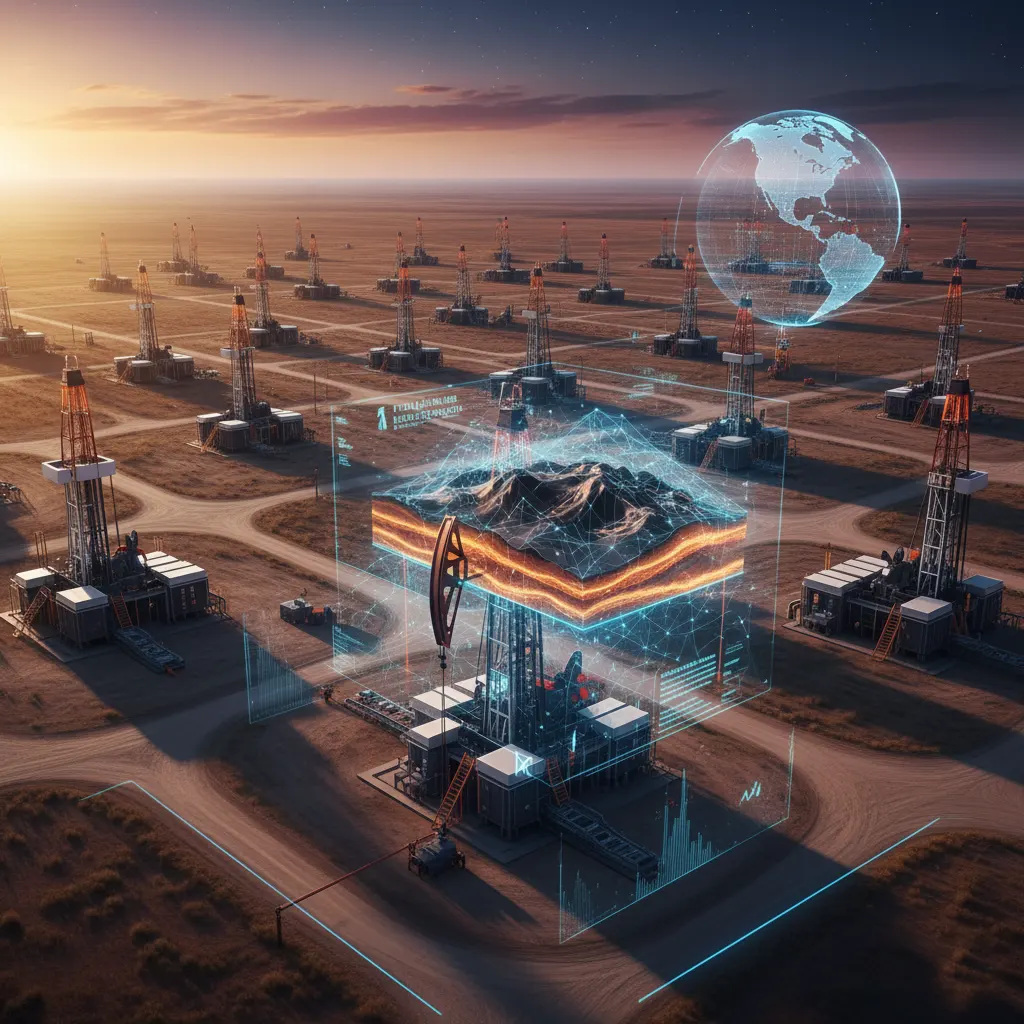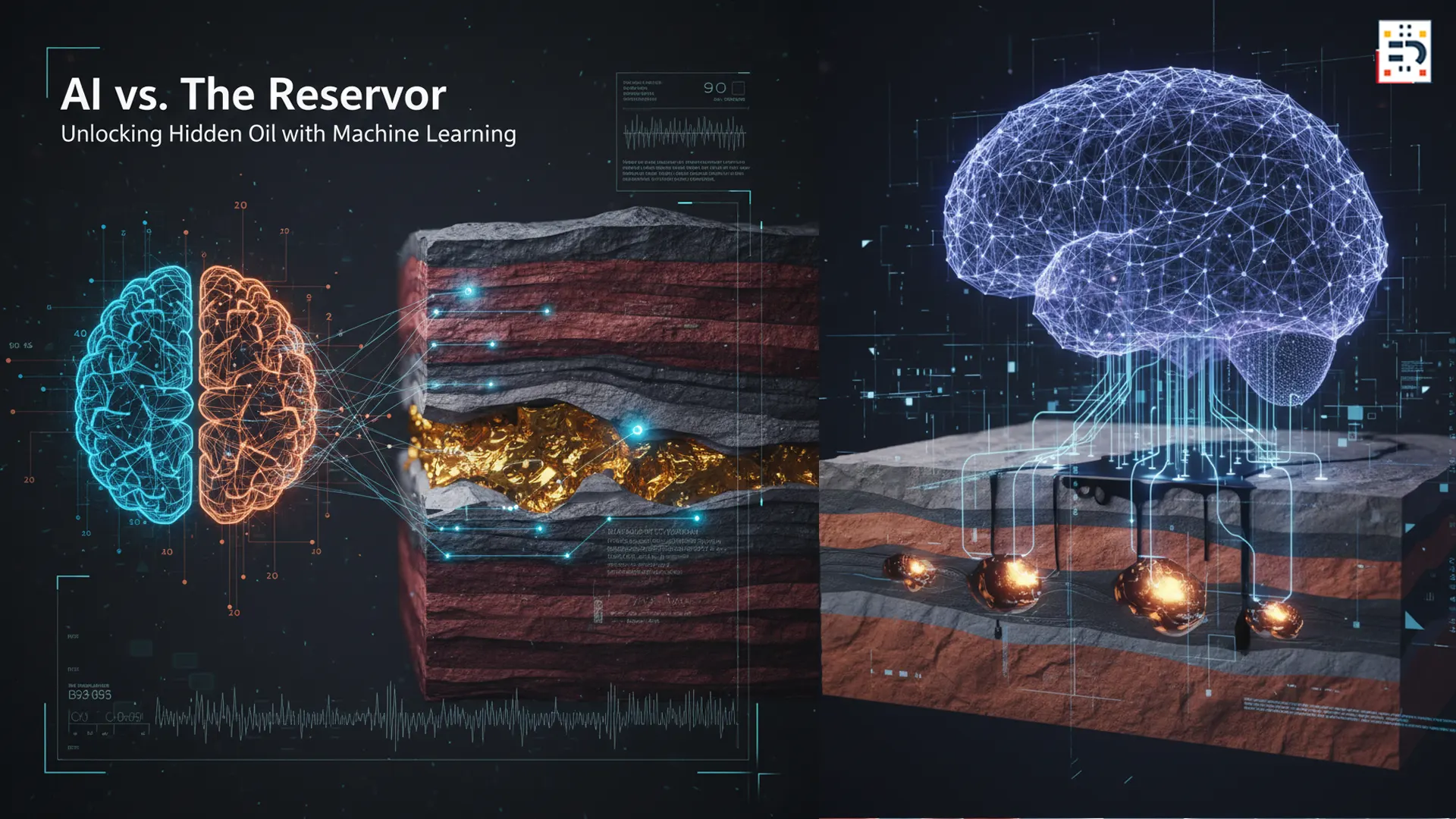Revolutionary AI Technology Unlocks Hidden Trillion-Barrel Oil Reserves in Existing Fields
For over a century, oil exploration has been a game of educated guesses, expensive gambles, and dry holes that drain corporate wallets. Geologists would spend months analyzing seismic data, drilling teams would invest millions in promising sites, and all too often, the result was nothing but disappointment and red ink on balance sheets.
But artificial intelligence in oil and gas is fundamentally rewriting the rules of oil discovery, and the numbers are staggering. Recent analysis reveals that existing oil fields contain an untapped treasure of between 470 billion to over 1 trillion barrels of recoverable oil—resources that humans have consistently overlooked despite decades of extraction. This isn’t about finding new fields in remote corners of the earth. It’s about AI-powered oil exploration revealing what’s been hiding in plain sight all along.
The Data Deluge That Humans Couldn’t Handle
The oil and gas industry has always been drowning in data. Every seismic survey, every drill bit sensor, every pressure reading, and every satellite image generates torrents of information. A single offshore rig can produce terabytes of data daily. For human analysts, this has been both a blessing and a curse—too much information to process effectively, too many patterns to recognize, too many variables to consider simultaneously.
Machine learning in petroleum industry thrives in exactly this environment. Advanced algorithms can now process vast datasets including seismic surveys, geological formations, well logs, and satellite imagery with a speed and precision that would take human teams months or years to achieve. These AI systems don’t just work faster; they identify patterns and correlations that human eyes simply cannot detect.
According to the U.S. Energy Information Administration, the integration of artificial intelligence with traditional exploration techniques has fundamentally transformed how companies approach reservoir analysis and production optimization.How AI Sees What Geologists Miss
Traditional exploration relied heavily on human interpretation of seismic waves bouncing through rock formations. A skilled geologist might examine seismic images for weeks, using experience and intuition to predict where oil might be hiding. But human cognition has inherent limitations—we’re prone to bias, we tire, we miss subtle patterns, and we can only consider a limited number of variables simultaneously.
AI-powered machine learning models approach the problem differently. They scan through thousands of seismic images and well logs simultaneously, identifying subsurface anomalies and analyzing rock properties across multiple dimensions. By training on historical drilling data combined with real-time inputs such as temperature, pressure, and geological characteristics, these systems can predict the presence of oil and gas deposits with remarkable accuracy.

Key AI Capabilities in Oil Discovery:
- Seismic Data Analysis: Processing thousands of seismic images simultaneously
- Pattern Recognition: Identifying geological formations invisible to human analysts
- Predictive Modeling: Forecasting reservoir behavior with unprecedented accuracy
- Real-Time Optimization: Adjusting drilling parameters instantaneously
The technology has proven particularly effective at reducing “dry holes”—those expensive explorations that yield nothing. By creating detailed three-dimensional models of underground formations and running countless simulations, AI in upstream oil and gas helps companies pinpoint viable locations with greater precision than ever before. This doesn’t just save money; it dramatically reduces the environmental impact of unnecessary drilling.
Learn more about how AI is transforming exploration at the Society of Petroleum Engineers.
The North American AI Advantage: Leading the Global Revolution
The United States is leading the global charge in AI-powered oil discovery. North America currently holds approximately 38.20% of the global AI in oil and gas market, valued at $2.61 billion in 2024 and projected to reach $7.34 billion by 2034. This dominance stems from the region’s digital maturity, advanced infrastructure, and the presence of major tech players like Google, IBM, and specialized AI firms such as C3.ai and Novi Labs.
Major US Oil Companies Embracing AI:
ExxonMobil deploys AI models to analyze real-time seismic data and historical drilling records, significantly enhancing its ability to detect natural oil seeps in oceanic settings. During the recent CERAWeek conference, industry leaders from Devon Energy, Chevron, and BP shared how AI technologies—including digital twins, machine learning for drill steering, and predictive maintenance—have dramatically improved asset reliability while making production faster and more cost-effective.
U.S. operators increasingly implement AI-powered technologies such as digital twins, predictive analytics, and autonomous drilling to enhance exploration, boost production, and improve safety. The Department of Energy has recognized AI as a critical component of America’s energy independence strategy.
Permian Basin: America’s AI Testing Ground
The impact is particularly visible in mature basins once thought to be depleting. The Permian Basin in Texas exemplifies this trend, with AI-driven real-time drilling optimization cutting drilling times by up to 30% for companies like Chevron. Chevron’s AI algorithms predict equipment failures before they happen, reducing unplanned downtime.
US operators are actively using AI for enhanced oil recovery, with companies reporting production uptime improvements of 27% and asset utilization optimization gains of 26%. This represents a fundamental shift in strategy: instead of chasing expensive new discoveries in frontier regions, AI enables companies to maximize recovery from fields that have been producing for decades.
The Permian Basin, spanning West Texas and New Mexico, has become the world’s proving ground for AI innovation. According to Hart Energy, operators in the region are achieving unprecedented efficiency gains through machine learning applications.
Finding the Oil That’s Already There: The Trillion-Barrel Opportunity
Perhaps the most remarkable revelation from recent AI analysis comes from Wood Mackenzie’s proprietary Synoptic AI system. Using machine learning to examine over 30,000 fields worldwide across more than 60 parameters, the analysis identified similar “analogue” fields—reservoirs with comparable geological characteristics but vastly different recovery rates.
The findings challenge decades of conventional wisdom. Since the 1980s, the industry has met growing demand primarily through upward revisions to existing fields rather than new discoveries. But even with this knowledge, most fields remain severely underutilized. The average recovery factor across the industry sits at just 29%—meaning that more than two-thirds of the oil in known reservoirs stays in the ground.
The Untapped Potential:
AI’s unbiased methodology reveals that achieving top-quartile performance industry-wide would boost average recovery factors to 34%, adding 470 billion barrels of reserves without drilling a single new well. The best-in-class scenarios, where fields adopt practices already successfully deployed elsewhere in the industry, could unlock over 1 trillion barrels. Critically, this potential doesn’t require unproven technologies—just the application of established best practices guided by AI insights.
The upside potential concentrates in:
- Onshore fields: 63% of opportunities
- Shallow offshore fields: 31% of opportunities
- Deepwater fields: Less than 6% (already optimized)
- National oil companies: Control nearly 70% of recovery potential
This revelation fundamentally changes the industry’s future. Energy security need not depend on unpredictable exploration in increasingly remote and challenging environments. According to analysis from McKinsey & Company, existing fields and proven recovery methods, guided by AI insights, can meet global demand through 2050 without major new discoveries.

The Technology Behind the Transformation: Deep Dive into AI Solutions
The AI revolution in oil discovery relies on several interconnected technologies working in concert. Understanding these systems reveals how dramatically the industry has evolved from traditional exploration methods.
1. Machine Learning and Neural Networks
Machine learning and neural network-based algorithms analyze vast amounts of data from sensors, satellites, seismic images and more to identify patterns and make predictions. They are helping with tasks like:
- Predictive maintenance of equipment
- Enhanced oil recovery from existing fields
- Improving drilling operations with more precise steering of drill bits
2. Deep Learning Systems
Deep learning systems utilize complex neural networks to process enormous publicly available datasets from government seismic surveys, identifying intricate details within subsurface structures. These systems can:
- Recognize geological formations with 95%+ accuracy
- Predict reservoir characteristics before drilling
- Optimize well placement for maximum production
3. Generative AI in Oil Exploration
Generative AI is emerging as a powerful new tool, analyzing geological maps, production data, and well logs to create sophisticated geo-models of crude oil and natural gas reserves. These models help engineers understand fluid movement through rock formations and predict long-term well performance. What once took months can now be accomplished in hours—a transformation that Deloitte highlights as particularly significant for reducing the time and cost of geo-model creation for optimal well placement.
4. Edge AI for Remote Operations
Edge AI represents another breakthrough, processing data locally on Internet of Things devices without relying on cloud storage or internet connectivity. For remote drilling operations or offshore platforms, this capability enables:
- Real-time decision-making based on sensor data
- Instant adjustments to drilling parameters
- Reduced equipment wear and tear
- Enhanced safety through immediate hazard detection
Companies are using AI-driven analytics to optimize weight-on-bit, drilling fluids, and rate of penetration (ROP) in real time.
5. Computer Vision and NLP
Natural language processing and computer vision round out the AI toolkit, interpreting human language for report generation and analyzing visual data for quality control and safety monitoring. Shell uses reinforcement learning to oversee drilling equipment, while Total SA partnered with Google Cloud to create AI solutions that streamline subsurface data analysis through computer vision.
For technical specifications and standards, refer to the American Petroleum Institute.
Real-World Success Stories: AI in Action Across America
The oil industry’s AI transformation isn’t theoretical—it’s already delivering results across North America and beyond. Here are the most compelling success stories from 2025:
Cairn Oil & Gas Launches CAIRA Platform
In June 2025, Cairn Oil & Gas launched CAIRA, its proprietary GenAI-based platform designed to improve business operations and boost efficiency. The system represents a new generation of AI specifically tailored for the complexities of oil and gas operations.
Novi Labs: Revolutionizing Energy Analytics
American companies and investors are increasingly funding AI-based energy analytics platforms. Novi Labs has emerged as a leader in enabling smarter capital deployment across oil, gas, and data center energy needs. The platform helps operators:
- Assess reservoir value with unprecedented accuracy
- Customize drilling and completion plans according to local geology
- Evaluate risks for individual wells
- Continuously improve through machine learning
Permian Basin Success Stories
The technology has proven particularly valuable in unconventional plays. Matador Resources’ simul-frac strategy reduces costs by $250,000 per well, while EOG Resources improved completion efficiency by 12%, increasing daily completion footage from 1,065 feet in 2023 to 1,178 feet in 2024.
Permian Resources reduced cycle times by 16%, dropping spud-to-rig release days to just 13 days. The gassy Appalachian basin has seen market capitalizations of top producers including Expand Energy, EQT, Range Resources, and Antero Resources spike by 25% to 75% over the past year.

Discovering Lost Wells with AI
Even abandoned and lost wells are being rediscovered through AI. Researchers at Lawrence Berkeley National Laboratory developed machine learning systems that dig through old maps and historical records to locate undocumented orphaned wells—potentially millions of forgotten drill sites that continue leaking methane into the atmosphere.
The technology, deployed in collaboration with the Osage Nation, has already led to discoveries of previously unknown wells. Craig Walker, director of Osage Nation Natural Resources, noted that “utilizing AI and state-of-the-art detection equipment has filled data gaps in records and led to the discovery of some undocumented wells in the area.”
SLB’s Autonomous Drilling Breakthrough
SLB, the world’s biggest oil-services provider, announced in January that it autonomously drilled sections of five wells off the coast of Brazil, leading to a 60% faster drilling time. Jesus Lamas, president of SLB’s well construction unit, said that in the next three to five years, 15% of all wells will be autonomously controlled by AI.
Visit World Oil for the latest industry updates and case studies.
The Economic and Environmental Case: Why AI Makes Business Sense
The financial implications of AI in oil discovery are profound and measurable. The AI in oil and gas market is projected to reach $7.64 billion in 2025 and expand to $25.24 billion by 2034, growing at a compound annual growth rate of 14.2%. This investment reflects the technology’s proven ability to deliver returns.
Cost Reduction Through AI:
A World Economic Forum report underscores that widespread AI adoption within the sector could yield a 10-20% reduction in costs—billions of dollars in savings for an industry where margins can be razor-thin.
Cost reduction comes from multiple sources:
- Minimized Dry Holes: Cutting exploration costs dramatically
- Optimized Drilling Operations: Reducing time and materials to reach productive depths
- Predictive Maintenance: Preventing equipment failures before they occur
- Enhanced Recovery: Delaying or eliminating the need for expensive new exploration
Production Improvements:
According to recent industry reports:
- 27% production uptime improvements
- 26% asset utilization optimization gains
- 30% reduction in drilling times
- $250,000+ savings per well in completion costs
Environmental Benefits
But perhaps most significantly in today’s climate-conscious environment, AI enables more sustainable operations. By pinpointing precisely where to drill, companies can minimize their environmental footprint:
- Fewer exploration wells = less habitat disruption
- Better production efficiency = reduced need to develop pristine areas
- Real-time leak detection = faster response and remediation
- Optimized energy consumption = lower carbon emissions
In recent years, oil and gas companies have focused on standing up the data foundations necessary to properly deploy AI. The Environmental Protection Agency recognizes AI’s potential to improve environmental compliance and reduce emissions.
The technology also supports the industry’s transition toward lower-carbon operations. AI helps identify opportunities for carbon capture and storage, optimizes energy consumption in production facilities, and enables better integration of renewable energy sources into operations. In January 2025, Italian oil and gas giant Eni launched its next-generation supercomputer specifically to enhance exploration capabilities while advancing decarbonization strategies—a combination that would have seemed contradictory just a few years ago.
Challenges and the Road Ahead: Navigating the AI Transformation
Despite impressive advances, AI implementation in oil discovery faces significant hurdles that must be addressed for widespread adoption.
Data Quality and Governance
AI systems are only as good as the data they train on, and the oil industry’s data landscape is fragmented across decades of operations, multiple formats, and varying standards. Many companies struggle with data silos, where information sits isolated in different departments or systems, preventing the holistic analysis that makes AI most powerful.
Cybersecurity Concerns
Cybersecurity concerns loom large as operations become increasingly digitized. Protecting sensitive geological data, operational information, and proprietary AI models from cyber threats requires constant vigilance and substantial investment. The integration of AI into critical infrastructure also creates potential vulnerabilities that didn’t exist in traditional operations.
Workforce Adaptation
Oil and gas companies face challenges in adopting AI due to a limited pool of skilled professionals who understand both AI and industry operations. The oil and gas workforce, traditionally rooted in hands-on expertise and field experience, must adapt to working alongside AI systems. This requires significant training and a cultural shift in how decisions are made.
Looking Forward: The Future of AI in Oil
Current adoption rates show that 44% of upstream organizations already use AI in exploration, with another 45% planning to implement it within three years. In downstream operations, 41% apply AI in refining, with 52% expecting to do so shortly. This rapid expansion suggests the technology is moving from early adopter phase to mainstream acceptance.
Key Future Trends:
- Generative AI Evolution: Next frontier in seismic data analysis, reservoir characterization, and virtual field assistance
- Quantum Computing Integration: Eventually enabling even more sophisticated modeling of complex geological systems
- 5G and Edge Computing: Real-time AI decision-making at drilling sites will become increasingly sophisticated
- Autonomous Operations: 15% of all wells will be autonomously controlled by AI within the next three to five years
According to EY’s oil and gas insights, successful AI adoption requires leadership buy-in, culture change, and constant feedback loops.
A New Era of Discovery
The oil industry stands at an inflection point. For the first time in its history, the technology exists to fully understand what lies beneath the earth’s surface—not through guesswork and intuition, but through rigorous data analysis that reveals patterns invisible to human observers.
The trillion-barrel opportunity identified by AI isn’t about discovering new frontiers. It’s about finally extracting the oil that’s been there all along, trapped in reservoirs we thought we understood but actually barely tapped. Machine learning has revealed the sobering truth: for every barrel of oil humans have successfully extracted, two more remain locked underground in fields we’ve been producing from for decades.
This revelation fundamentally changes the industry’s future. Security of supply need not depend on unpredictable exploration in increasingly remote and challenging environments. Existing fields and proven recovery methods, guided by AI insights, can meet global demand through 2050 without major new discoveries. For an industry facing pressure to reduce its environmental footprint while meeting the world’s energy needs, this represents more than just an opportunity—it’s a necessity.
The AI Advantage is Clear:
The competition between human intuition and machine intelligence is over. AI hasn’t just matched human geologists; it’s revealed that we’ve been missing the majority of recoverable oil this entire time. The question now isn’t whether AI will transform oil discovery, but how quickly the industry can deploy these technologies at scale to unlock the resources that have been hiding in plain sight.
In the end, the reservoir always wins against human observation alone. But artificial intelligence has given us new eyes to see what we’ve been missing—and the potential to change the energy equation for decades to come.
With North America leading the charge and American companies at the forefront of innovation, the AI revolution in oil discovery represents both a competitive advantage and a technological imperative for the US energy sector in 2025 and beyond.
Related Resources and Further Reading
- U.S. Energy Information Administration – Oil & Gas Data
- Society of Petroleum Engineers – AI Technology
- American Petroleum Institute – Industry Standards
- Department of Energy – Energy Innovation
- World Oil Magazine – Latest Industry News
- Hart Energy – Exploration & Production
Frequently Asked Questions (FAQ)
Q: How is AI different from traditional oil exploration methods? A: AI processes thousands of data points simultaneously, identifying patterns invisible to human analysts. Traditional methods rely on human interpretation of limited data sets, making them slower and less accurate.
Q: What percentage of oil remains in existing reservoirs? A: Current industry average shows only 29% recovery rate, meaning over 70% of oil remains underground in known fields. AI can help boost this to 34-40%.
Q: Which US oil basins are using AI most effectively? A: The Permian Basin in Texas, the Bakken Formation in North Dakota, and the Marcellus Shale in Pennsylvania are leading AI adoption.
Q: How much can AI reduce drilling costs? A: Industry reports show 10-20% cost reductions, with some companies achieving up to 30% faster drilling times and $250,000+ savings per well.
Q: Is AI replacing human geologists? A: No. AI augments human expertise, handling data processing while geologists focus on strategic decision-making and interpretation.
Q: What companies are leading AI adoption in US oil? A: ExxonMobil, Chevron, BP, Shell, Devon Energy, ConocoPhillips, and EOG Resources are among the leaders.
#AIInOilAndGas #MachineLearning #OilDiscovery #ArtificialIntelligence #PetroleumIndustry #EnergyTech #OilAndGas #DigitalTransformation #Innovation #TechTrends2025


